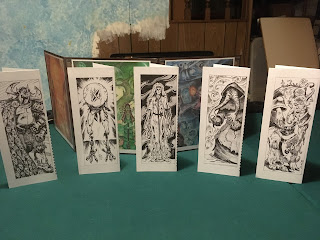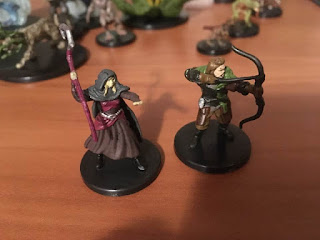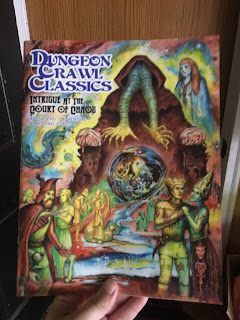A "death curse" is afflicting anyone who has ever been resurrected, sapping them of strength and spirit with every passing day, and anyone who succumbs to death is unable to be brought back by magical means. The players were tasked with embarking on a journey to the jungle peninsula Chult, with full knowledge that we are playing under the oppressive "meat grinder" rules - setting the DC for death saving throws at 15 as opposed to the normal 10.
Lets introduce the expendables...
The Adventuring Party
Billebrick Puddlecake - Forest gnome rogue
- Originally from Yellyark located on Chult.
- Archaeologist who is seeking lost artifacts related to Dwarven lore.
Reginald "Reggie" Itsame - Human paladin
- An earnest and naive follower of Torm, in service to the Order of the Gauntlet.
Klaus Kringle - Half-elf fighter
- Indentured servant who works for Syndra Silvane. A sleep spell slowed his aging and has a weakness for intoxicants.
The Story Begins...
The party was summoned to the residence of a retired adventurer and merchant named Syndra Silvane in Baldur's Gate. She organized them on an expedition to Chult, a land of hot jungle and dangers including undead, pirates and dinosaurs (oh my!). Her contacts with the Harpers shared that a device called the Soulmonger was believed to be somewhere on Chult and that it was related to the death curse, of which she is currently afflicted.The party agreed to go with her to Port Nyanzaru, the only city on the peninsula. Given the choice of a nice, calm and quiet place to lay their heads for the evening and a raucous place known for trouble, the PCs of course chose the latter. It wasn't long before they attempted to engage in negotiations with a drunk foreigner who wouldn't let them forget his name ("Voltan! OHHH YEAH!").
- Sindri attempted to intervene, armed only with his "words." This was ineffective against the very intoxicated man.
- Klaus, armed with his great axes sauntered up like John Wayne and stared the man straight into the eyes and caused him to soak his pants and flee the bar.
- The entire tavern was thankful and bought the party rounds upon rounds of tej, a fermented honey liquor. Sindri and Reggie quickly succumbed to intoxication while Billebrick and Klaus learned from the locals about ancient cities, snake people, and gossip related to a Merchant Prince named Jobal who put a moratorium on guides going into the jungles due to the undead threat.
Twenty Sides to the Politics
In the morning, the PCs required much bacon to help deal with hangovers and shame. They decided to meet one of the seven Merchant Princes, Wakanga O'tamu; a friend of Syndra Silvane's. He treated them to an exotic feast and discussed their prospects of going into the jungles. He confirmed that they would need a guide to go into the jungle and would need to get permission from Jobal.- Sindri ate some dancing monkey fruit which caused him to summon forth some highland dancing skills he didn't know he had.
- Wakanga shared with the party a map where he believes a shield guardian (a magical construct) could be found. He was hoping to get the PCs to get it for him, and tried to take back the quest after he suspected they might try to keep it for themselves. Unfortunately, the cat was already out of the bag.
- Wakanga agreed to try and help them meet Jobal, but suggested they might have more luck if they went to Goldenthrone to happen upon him incidentally.
The heroes went to Goldenthrone as Wakanga suggested and requested from the guards that eyed them suspiciously for a meeting with the merchant prince, Jobal. They were asked to wait and were left on the street for three hours. Poor Sindri was feeling a little sick from the foreign cuisine, and still under the effects of the dancing monkey fruit, was forced to try and conceal a "number two" in a back alley. The stealth check for doing his business failed, and in an unfortunately mix of defecation and dancing became the talk of the town and Chultan people began throwing coins in his direction.
Soon the party was summoned before a different prince: a grandmotherly figure who introduced herself as Zhanthi. After hearing their need for a guide, she suggested she could get them an immediate audience with Jobal and pay them 50gp for the delivery of a coin. She gave them a silver coin with a triceratops molded into it and told them to come by later while she was having a meeting with yet another merchant prince, named Ifan Talro'a. Her mission required discretion and she assured them that no harm would come of them.
They dutifully did as asked and found that Ifan quickly began threatening them with "sanctions." Zhanthi tried to communicate through innuendo to the party, but no one was able to pick up her message. Zhanthi suggested that the coin came from Kwayothe, another merchant prince who she accused of conspiring with the Flaming Fists of Baldur's Gate. Ifan tasked them with finding evidence of collusion. Klaus suggested they be given some type of a flying dinosaur for their trouble, to which he agreed. The party required no more motivation than that.
Cloak and Dagger
The PCs decided to try and break in to Kwayothe's residence late at night when a supposed meeting was occurring between her and Liara Portier, an agent of the Flaming Fists.
- Billebrick Puddlecake scaled the wall of the garden with a boost from Klaus. He snuck inside and overheard a strange conversation between Liara and Zhanthi. The negotiation of a deal to bring Flaming Fist mercenaries into town to replace the current town guard went a little too smoothly. A contract was signed and Billebrick was forced to retreat from eavesdropping. He was able to recover the contract from its hiding place in the library.
- Meanwhile, as the rest of the party waited outside they were discovered by a familiar face...VOLTAN! He was backed up with thugs from the pirate ship where he is the first mate. The battle which ensued brought the PCs down to 0 hp through the use of non-lethal damage.
Overall
Only two hours into the game and we have our first split party scenario! Why did Voltan and his crew not kill Klaus, Sindri and Reggie? What will Billebrick do when he discovers his comrades missing? Join us Thursday, October 5th at 7pm to find out!











































